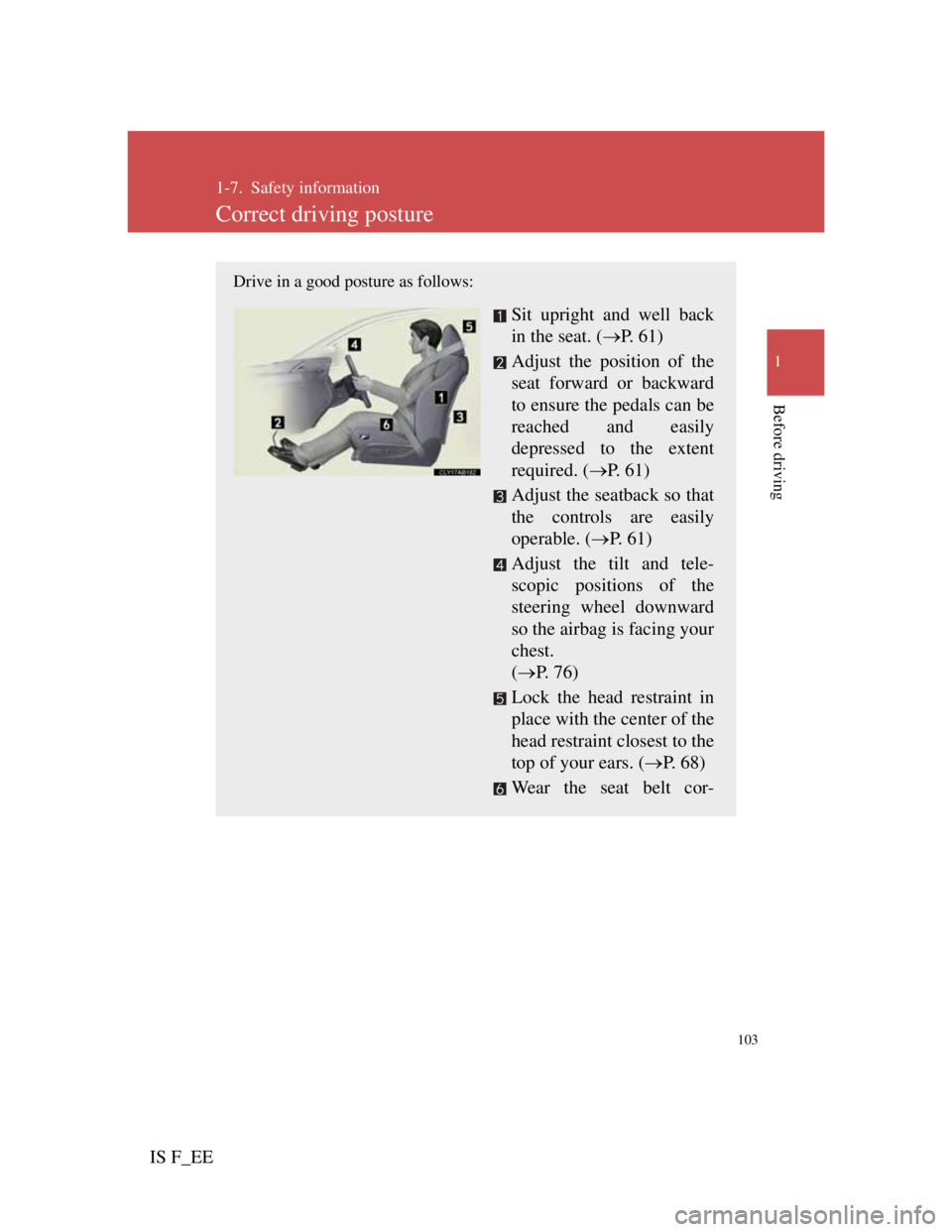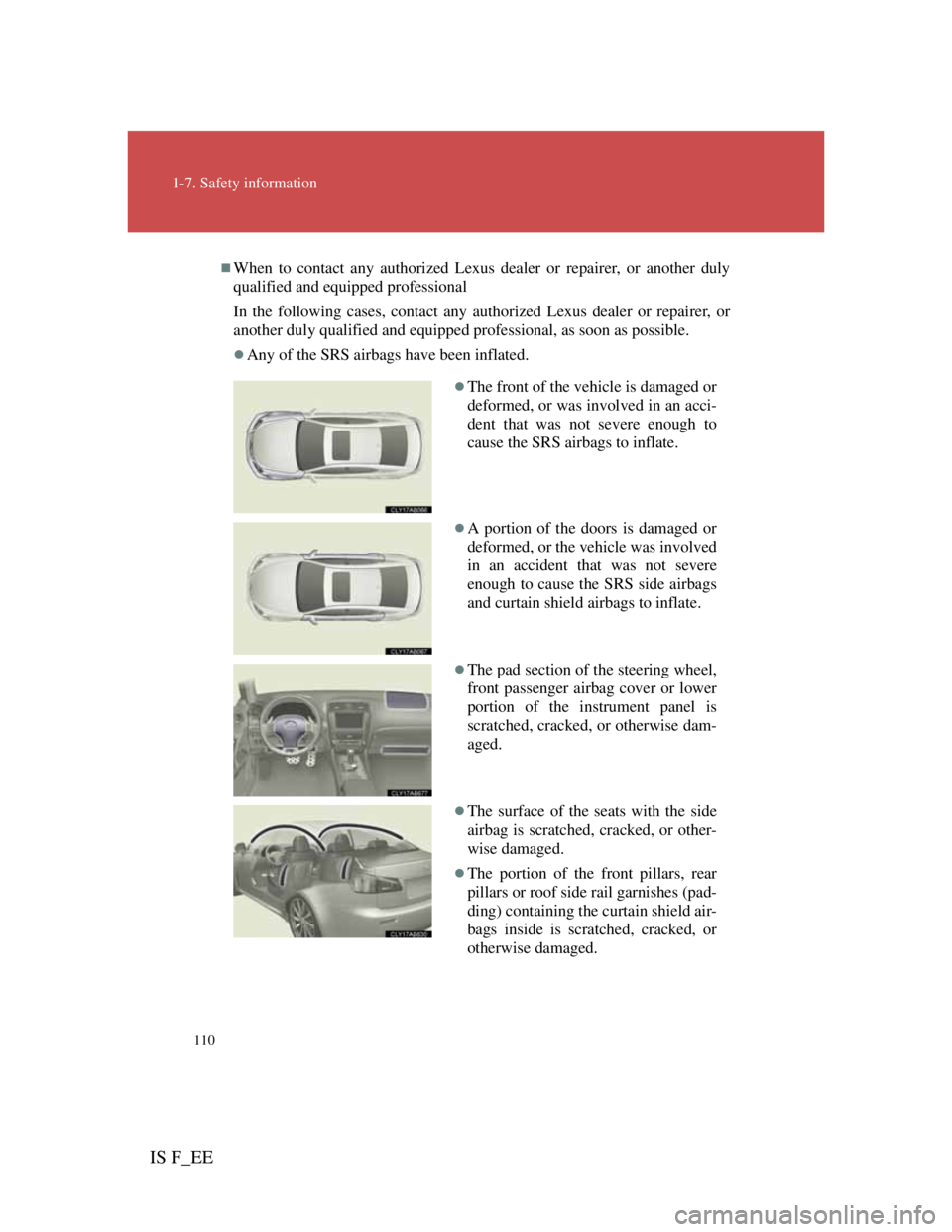steering wheel Lexus IS F 2011 Owner's Guide
[x] Cancel search | Manufacturer: LEXUS, Model Year: 2011, Model line: IS F, Model: Lexus IS F 2011Pages: 529, PDF Size: 13.89 MB
Page 83 of 529

78
1-3. Adjustable components (seats, mirrors, steering wheel)
IS F_EE
CAUTION
Caution while driving
Do not adjust the steering wheel while driving.
Doing so may cause the driver to mishandle the vehicle and cause an acci-
dent, resulting in death or serious injury.
Page 84 of 529

79
1-3. Adjustable components (seats, mirrors, steering wheel)
1
Before driving
IS F_EE
Anti-glare inside rear view mirror
Adjusting the height of rear view mirror
Adjust the height of the rear
view mirror by moving it up
and down.
In automatic mode, sensors are used to detect the headlights of vehi-
cles behind and automatically reduce the reflected light.
Turns automatic mode on/off
The indicator comes on when
automatic mode is turned on.
The anti-glare mirror default
mode is automatic. The anti-
glare mirror is automatically
set to automatic whenever the
“ENGINE START STOP”
switch is turned IGNITION
ON d
Page 85 of 529

80
1-3. Adjustable components (seats, mirrors, steering wheel)
IS F_EE
To prevent sensor error
CAUTION
Caution while driving
Do not adjust the position of the mirror while driving.
Doing so may lead to mishandling of the vehicle and an accident, resulting
in death or serious injury.
To ensure that the sensors operate prop-
erly, do not touch or cover them.
Page 86 of 529

81
1-3. Adjustable components (seats, mirrors, steering wheel)
1
Before driving
IS F_EE
Outside rear view mirrors
Folding back the mirrors
Press the button to fold back the
mirrors
Push once more to return to the
original position.
Mirror angle can be adjusted using the switch when the “ENGINE
START STOP” switch is in ACCESSORY or IGNITION ON mode.
Select a mirror to adjust
(“L”: left or “R”: right)
Adjust the mirror up,
down, in, or out using the
switch
Page 87 of 529

82
1-3. Adjustable components (seats, mirrors, steering wheel)
IS F_EE
The mirrors can be operated when
The “ENGINE START STOP” switch is in ACCESSORY or IGNITION
ON mode.
When the mirrors are fogged up
Turn on the mirror defoggers to defog the mirrors. (P. 236)
One-touch adjustment of the mirror angle
A desired mirror face angle can be entered to memory and adjusted with the
touch of a button. (P. 6 2 )
Linked mirror function when reversing
The outside rear view mirrors will automatically angle downwards when the
vehicle is reversing in order to give a better view of the ground. However,
this function will not operate when the mirror select switch is in the neutral
position (between “L” and “R”).
Auto anti-glare function
When the anti-glare inside rear view mirror is set to automatic mode, the
outside rear view mirrors will activate in conjunction with the anti-glare
inside rear view mirror to reduce reflected light. (P. 7 9 )
Page 88 of 529

83
1-3. Adjustable components (seats, mirrors, steering wheel)
1
Before driving
IS F_EE
CAUTION
When driving the vehicle
Observe the following precautions while driving.
Failing to do so may result in loss of control of the vehicle and cause an
accident, resulting in death or serious injury.
Do not adjust the mirrors while driving.
Do not drive with the mirrors folded back.
Both the driver and passenger side mirrors must be extended and properly
adjusted before driving.
When a mirror is moving
To avoid personal injury and mirror malfunction, be careful not to get your
hand caught by the moving mirror.
When the mirror defoggers are operating
Do not touch the rear view mirror surfaces, as they can become very hot and
burn you.
Page 111 of 529

103
1
Before driving
IS F_EE
1-7. Safety information
Correct driving posture
Drive in a good posture as follows:
Sit upright and well back
in the seat. (P. 6 1 )
Adjust the position of the
seat forward or backward
to ensure the pedals can be
reached and easily
depressed to the extent
required. (P. 61)
Adjust the seatback so that
the controls are easily
operable. (P. 61)
Adjust the tilt and tele-
scopic positions of the
steering wheel downward
so the airbag is facing your
chest.
(P. 76)
Lock the head restraint in
place with the center of the
head restraint closest to the
top of your ears. (P. 68)
Wear the seat belt cor-
Page 115 of 529

107
1-7. Safety information
1
Before driving
IS F_EE
If the SRS airbags deploy (inflate)
Bruising and slight abrasions may result from contact with a deploying
(inflating) SRS airbag.
A loud noise and white powder will be emitted.
Parts of the airbag module (steering wheel, airbag cover and inflator) as
well as the front seats, and parts of the front pillar, rear pillar and roof
side rail, may be hot for several minutes. The airbag itself may also be
hot.
The windshield may crack.
SRS airbag deployment conditions (front airbags)
The SRS front airbags will deploy in the event of an impact that exceeds
the set threshold level (the level of force corresponding to an approxi-
mately 20 - 30 km/h [12 - 18 mph] frontal collision with a fixed wall that
does not move or deform).
However, this threshold velocity will be considerably higher if the vehicle
strikes an object, such as a parked vehicle or sign pole, which can move or
deform on impact, or if the vehicle is involved in an underride collision
(e.g. a collision in which the front of the vehicle “underrides”, or goes
under, the bed of a truck, etc.).
It is possible that in some collisions where the forward deceleration of
the vehicle is very close to the designed threshold level, the SRS front
airbags and the seat belt pretensioners may not activate together.
SRS airbag deployment conditions (side and curtain shield airbags)
The SRS side airbags and SRS curtain shield airbags will deploy in the
event of an impact that exceeds the set threshold level (the level of force
corresponding to the impact force produced by an approximately 1500 kg
[3300 lb.] vehicle colliding with the vehicle cabin from a direction perpen-
dicular to the vehicle orientation at an approximate speed of 20 - 30 km/h
[12 - 18 mph]).
Page 118 of 529

110
1-7. Safety information
IS F_EE
When to contact any authorized Lexus dealer or repairer, or another duly
qualified and equipped professional
In the following cases, contact any authorized Lexus dealer or repairer, or
another duly qualified and equipped professional, as soon as possible.
Any of the SRS airbags have been inflated.
The front of the vehicle is damaged or
deformed, or was involved in an acci-
dent that was not severe enough to
cause the SRS airbags to inflate.
A portion of the doors is damaged or
deformed, or the vehicle was involved
in an accident that was not severe
enough to cause the SRS side airbags
and curtain shield airbags to inflate.
The pad section of the steering wheel,
front passenger airbag cover or lower
portion of the instrument panel is
scratched, cracked, or otherwise dam-
aged.
The surface of the seats with the side
airbag is scratched, cracked, or other-
wise damaged.
The portion of the front pillars, rear
pillars or roof side rail garnishes (pad-
ding) containing the curtain shield air-
bags inside is scratched, cracked, or
otherwise damaged.
Page 119 of 529

111
1-7. Safety information
1
Before driving
IS F_EE
CAUTION
SRS airbag precautions
Observe the following precautions regarding the airbags.
Failure to do so may cause death or serious injury.
The driver and all passengers in the vehicle must wear their seat belts
properly.
The SRS airbags are supplemental devices to be used with the seat belts.
The SRS driver airbag deploys with considerable force, and can cause
death or serious injury especially if the driver is very close to the airbag.
Since the risk zone for driver airbag is the first 50 - 75 mm (2 - 3 in.) of
inflation, placing yourself 250 mm (10 in.) from your driver airbag pro-
vides you with a clear margin of safety. This distance is measured from
the center of the steering wheel to your breastbone. If you sit less than 250
mm (10 in.) away now, you can change your driving position in several
ways:
• Move your seat to the rear as far as you can while still reaching the
pedals comfortably.
• Slightly recline the back of the seat.
Although vehicle designs vary, many drivers can achieve the 250 mm
(10 in.) distance, even with the driver seat all the way forward, simply
by reclining the back of the seat somewhat. If reclining the back of
your seat makes it hard to see the road, raise yourself by using a firm,
non-slippery cushion, or raise the seat if your vehicle has that feature.
• If your steering wheel is adjustable, tilt it downward. This points the
airbag toward your chest instead of your head and neck.
The seat should be adjusted as recommended above, while still maintain-
ing control of the foot pedals, steering wheel, and your view of the instru-
ment panel controls.